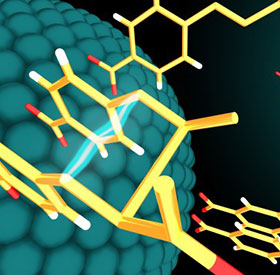Research Highlight: Weiss
Visible Light and Nanoparticle Catalysts Produce Desirable Bioactive Molecules
We design semiconductor nanoparticles (or “quantum dots”, QDs) to act as light-powered enzymes – systems that transduce light to chemical energy under only specific conditions, to template chemo- and stereoselective chemical reactions. In the past, we proved that QDs are powerful visible-light photocatalysts for the multi-electron transformation of CO2 to CO, and were the first to use QDs as photocatalysts for carbon-carbon coupling, living polymerizations, and deprotection reactions. We increased the efficiencies of CO2 reduction by 11´ and proton reduction by 13´ using QDs as building blocks for artificial photosynthetic systems that funnel energy to catalysts. More recently, we tuned the surfaces of QDs to drive alcohol oxidation with >90% product selectivity, and proved the usefulness of QD photocatalysts in a transition metal-catalyzed coupling. Most prominently, in a 2019 Nature Chemistry paper, we demonstrated that QDs photocatalyze stereoselective [2+2] photocycloadditions of olefins to form tetrasubstituted cyclobutanes, components of many lead compounds for drug development, through triplet-triplet energy transfer from QDs to alkenes reversibly self-assembled on their surfaces. Prior to our work, photochemical syntheses of these compounds were limited by poor regio- and diastereoselectivity, and by the inability to selectively achieve heterocoupling within a mixture of reactive alkenes. We showed that QDs are visible-light photocatalysts and reusable scaffolds for homo- and hetero-intermolecular [2+2] photocycloadditions of alkenes with up to 98% switchable regioselectivity and diastereomeric ratios of ~40:1, >10´ those achieved using all other sensitizers. We are currently using a QD’s high-energy exciton to make tetrasubstituted cyclobutanes that are energetically inaccessible to any molecular sensitizer, functionalizing the QD with chiral ligands to achieve enantioselective couplings, and performing one-pot cascade reactions using the distance- and excitation wavelength-dependence of triplet-triplet energy transfer. We believe QD photocatalysts will dramatically impact the synthesis of many complex molecules.

